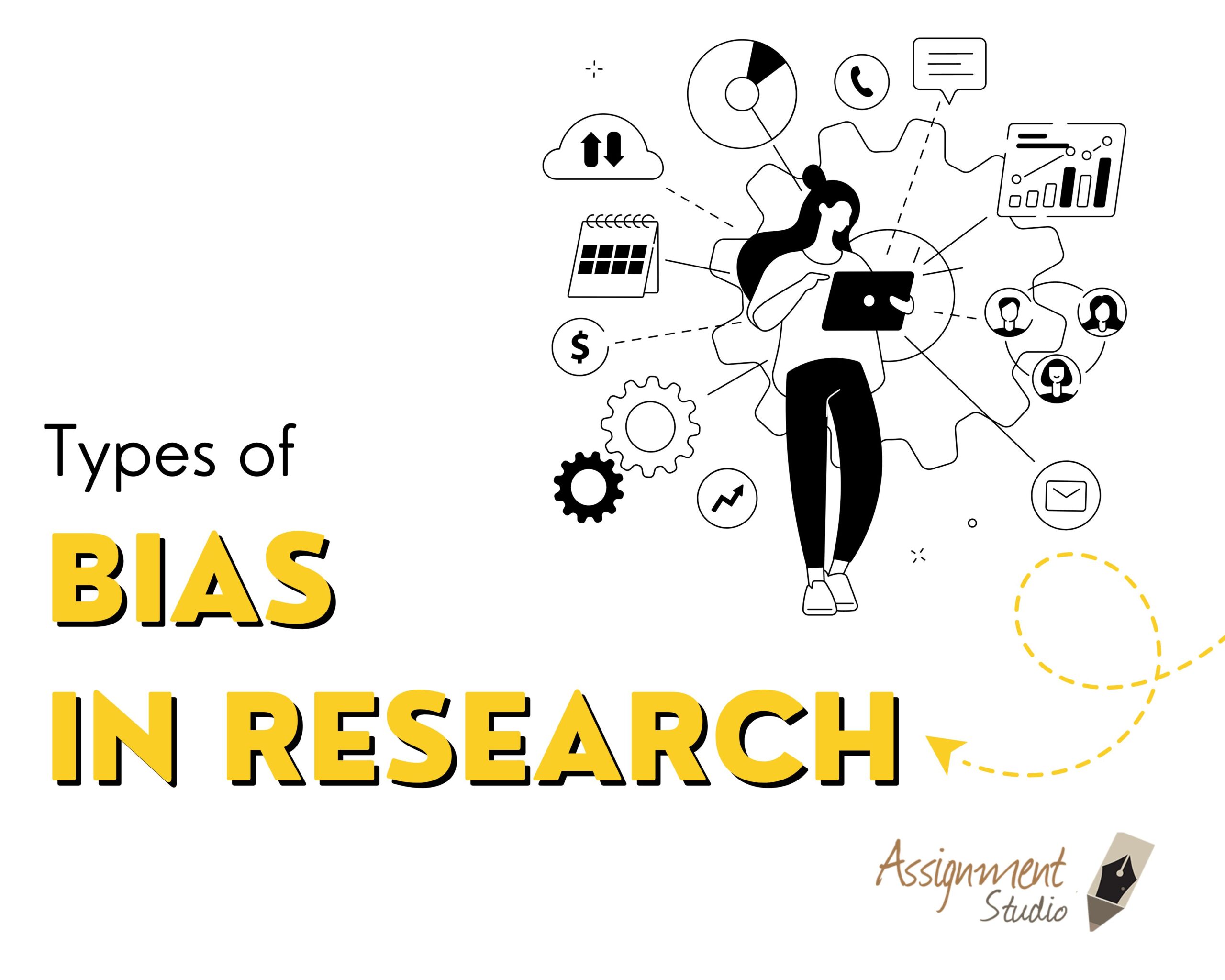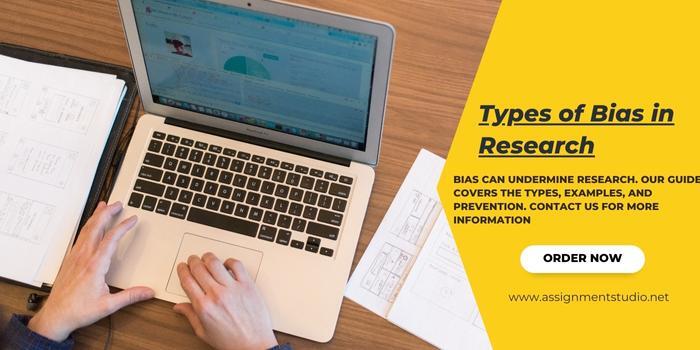
Research bias results from any deviation from the truth, causing distorted results and wrong conclusions. Bias can occur at any phase of your research, including during data collection, data analysis, interpretation, or publication.
Understanding research bias is important for several reasons.
- Bias exists in all research, across research designs, and is difficult to eliminate.
- Bias can occur at any stage of the research process.
- Bias impacts the validity and reliability of your findings, leading to misinterpretation of data.
Table of Contents
TYPES OF BIAS IN RESEARCH
Bias can be seen in practically every aspect of quantitative research and qualitative research, and it can come from both the survey developer and the participants. The sorts of biases that come directly from the survey maker are the easiest to deal with out of all the different types of bias in research. Let’s look at some of the most typical research biases.
Design bias
Design bias happens when a researcher fails to capture the biased views present in most types of experiments. It has something to do with the organization and methods of your research. The researcher must demonstrate that they realize this and have made every effort to mitigate its influence.
Confirmation bias
Confirmation bias is the tendency to seek out information in a way that supports our existing beliefs while also rejecting any information that contradicts those beliefs. Confirmation bias is often unintentional but still results in skewed results and poor decision-making.
Information bias
Information bias, also called measurement bias, arises when key study variables are inaccurately measured or classified. Information bias occurs during the data collection step and is common in research studies that involve self-reporting and retrospective data collection. It can also result from poor interviewing techniques or differing levels of recall from participants.
The main types of information bias are:
- Recall bias
- Observer bias
- Performance bias
- Regression to the mean (RTM)
Recall bias
Recall bias is a type of information distortion. It occurs when respondents are asked to recall events in the past and are common in studies that involve self-reporting.
Observer bias
Observer bias is the tendency of research participants to see what they expect or want to see rather than what is actually happening. Observer bias can affect results in observational and experimental studies where subjective judgment (such as reviewing a medical image) or measurement (such as rounding blood pressure values up or down) is part of the data collection process.
Observer bias leads to overestimation or underestimation of true values, which in turn compromises the validity of your findings. You can reduce observer bias by using double-blind and single-blind research methods.
Performance bias
Performance bias is unequal care between study groups. Performance bias mainly occurs in medical research experiments when participants have knowledge of the planned intervention, therapy, or drug study before it begins.
Regression to the Mean (RTM)
Regression to the mean (RTM) is a statistical phenomenon that refers to the fact that a variable that shows an extreme value on the first measurement will tend to be closer to the centre of its distribution on the second measurement. Medical research is particularly sensitive to RTM.
Interviewer bias
Interviewer bias stems from the person conducting the research study. This can result from the way they ask questions or react to answers, but also from any aspect of their identities, such as their gender, ethnicity, social class or perceived attractiveness.
Interviewer bias biases responses, especially if the characteristics are somehow related to the research topic. Interviewer bias can also affect the interviewer’s ability to relate to interviewees, making them less comfortable expressing their honest opinions about sensitive or personal topics.
Publication bias
Publication bias occurs when the decision to publish research results is based on their nature or the direction of their results. Studies reporting results that are perceived as positive, statistically significant, or favouring the study hypotheses are likely to be published due to publication bias.
Researcher bias
Researcher bias occurs when the researcher’s beliefs or expectations influence the research design or data collection process. Researcher bias can be intentional (for example, claiming that an intervention worked when it did not) or unconscious (for example, letting personal feelings, stereotypes, or assumptions influence research questions).
Response bias
Response bias is a general term used to describe a number of different situations where respondents tend to give inaccurate or false answers to self-report questions, such as those asked in surveys or structured interviews.
Common types of response bias are:
- Acquiescence bias
- Demand characteristics
- Social desirability bias
- Courtesy bias
- Question-order bias
- Extreme responding
Acquiescence bias
Acquiescence bias is the tendency of respondents to agree with a statement when faced with binary response options such as “agree/disagree,” “yes/no,” or “true/false.” Consent is sometimes referred to as “saying yes”.
Social desirability bias
Social desirability bias is the tendency of participants to give answers that they believe will be evaluated favourably by the researcher or other participants. It often affects studies that focus on sensitive topics such as alcohol consumption or sexual behaviour.
Courtesy bias
Courtesy bias stems from the reluctance to give negative feedback in order to be polite to the person who asked the question. Small group interviews where the participants relate to each other in some way (e.g., student, teacher, and dean) are particularly susceptible to this type of bias.
Selection bias
Selection bias is a general term describing situations where bias is introduced into research from factors affecting the study population.
Common types of selection bias are:
- Sampling or ascertainment bias
- Attrition bias
- Volunteer or self-selection bias
- Survivorship bias
- Nonresponse bias
- Undercoverage bias
Nonresponse bias
Nonresponse bias occurs when those who do not respond to a survey or research project differ from those who do in ways that are fundamental to the research objectives. This is very common in a survey where participants are unable or unwilling to participate due to factors such as a lack of necessary skills, lack of time, or feelings of guilt or shame related to the topic.
Under coverage bias
Undercoverage bias occurs when you only sample a subset of the population of interest. Online surveys may be particularly susceptible to concealment bias. Although more cost-effective than other methods, they may introduce hidden bias due to the exclusion of people who do not use the Internet.
How to avoid research bias
- Collect data from multiple sources: Make sure you collect data samples from different groups in your research population.
- Validate your data: Before proceeding with data analysis, try connecting to other data sources to confirm that you are on the right track.
- If possible, ask research participants to help you review your findings: Ask the people who provided the data if your interpretations seem to represent their beliefs.
- Look for alternative explanations: Try to identify and explain alternative reasons why you might have collected the data samples the way you did.
- Ask other members of your team to check your results: Ask others to check your conclusions. This will help you see things you missed or identify gaps in your argument that need to be addressed.
Conclusion
You need to understand biases in research and how to deal with them. It is also necessary to have a clear idea to recognize it in any form. Knowing the different types of bias in research allows you to easily identify them.








